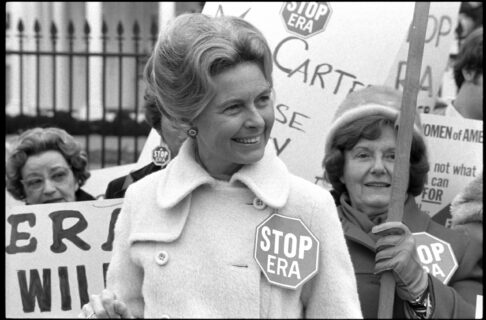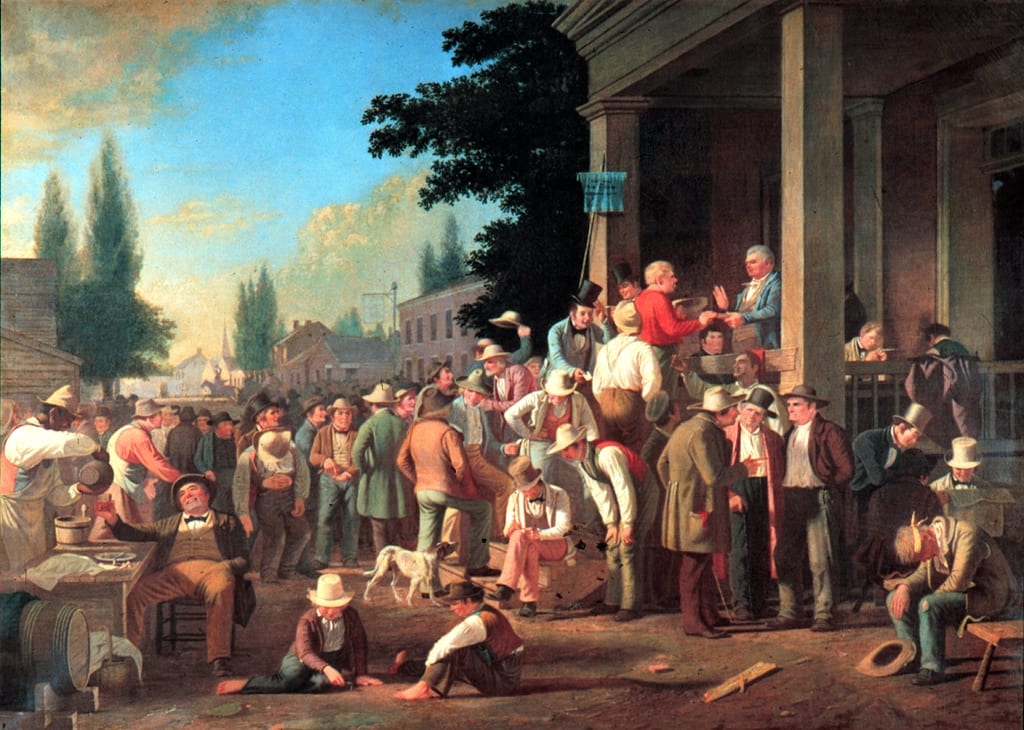
A War Among Women?
40 years ago, on June 30, 1982, the Equal Rights Amendment (ERA) fell 3 states short of ratification. To remember that event, we are re-running a blog that details the fight for the ERA.
On October 7, 1983, I boarded a flight at Chicago’s O’Hare airport bound for Washington National. The flight was one leg of a journey that would end in Raleigh, NC, where I would marry my best friend the next day. My bride-to-be was a feminist, a career-oriented, high achieving member of the National Organization of Women, and a strong supporter of the Equal Rights Amendment. In 1983, the ERA had been re-introduced in Congress and was struggling to win ratification. Opposition to the ERA’s ratification, led by Phyllis Schlafly, emerged in the 1970s after 28 states had ratified the amendment, stalling what had appeared to be its inevitable ratification.
So – imagine my amusement when I made my way to my seat on the plane, glanced at my seatmate for the trip to DC, and saw it was none other than Phyllis Schlafly herself. I would have enjoyed a courteous back and forth exchange with Mrs. Schlafly about her opposition to the ERA. I wanted to tell her I was proudly marrying someone who opposed her views on women’s role in American society. I wondered—Would she tell me not to marry this woman? But, unfortunately, Schlafly never looked up from the papers she was reading, so I chose not to bother her. Now, nearly thirty-eight years later, I still wonder what Schlafly would have thought of my impending marriage to a feminist who kept her maiden name and her career. I wonder what Schlafly would make of the millions of “non-traditional marriages” many Americans enjoy today.
In some respects, women’s struggle to gain full social and political rights in the United States mirrors the struggle of African Americans. During the Revolution, a few voices were calling for an end to slavery, noting it was incompatible with the Declaration of Independence’s ringing endorsement of the equality of all men. Likewise, a few female voices—like Abigail Adams, who famously asked her husband to “remember the ladies” as he worked for independence and new forms of republican government—challenged male attitudes toward women. Phillis Wheatley, Judith Sargent Murray, and Mercy Otis Warren are examples of America’s Founding Mothers who argued that men did not enjoy intellectual superiority over women. In 1792, British author Mary Wollstonecraft published “A Vindication of the Rights of Woman.” She argued that women’s alleged intellectual inferiority was attributable to girls’ lack of educational opportunities, not their natural gifts. In the mid 19th century—1848—as the abolitionist movement gained steam, women gathered in Seneca Falls, NY, for the nation’s first women’s rights convention. The Declaration of Sentiments issued by that convention proclaimed women’s equality and demanded the vote—a right not fully guaranteed by the Constitution until the ratification of the 19th Amendment in 1920.
Slavery had ended in the United States fifty-five years before women could legally vote nationwide. The Constitution protected black male suffrage on paper, but most blacks were systematically denied access to the polls by various methods. As African Americans increasingly left the Jim Crow South for marginally greener pastures in northern cities and the NAACP launched court challenges to segregation, the Equal Rights Amendment—in 1923—was introduced in Congress for the first time. The amendment was re-introduced in Congress every session from 1923 until it passed in 1972. Congress set 1979 as the deadline for ratification.
When 28 states ratified the ERA by the mid-1970s, feminists began hoping that the legal victories won by the Civil Rights Movement were about to be replicated by the Women’s Rights Movement. Indeed, it seemed the women’s movement in the 1970s was following in the successful footsteps of the 1960s Civil Rights Movement. African Americans won notable legislative advances with the Civil Rights Act of 1964 and the Voting Rights Act of 1965. In the 1970s, women were beginning to enter the professions in greater numbers, and, in 1973, many feminists cheered when the Supreme Court found a constitutional right of privacy gave women some rights in terminating a pregnancy.
Enter Phyllis Schlafly. In many ways, Schlafly’s career seemed to be just the type of career feminists believed women were entitled to choose. Schlafly began working for conservative causes in the 1940s. She was an attorney, author, and speaker, who twice ran unsuccessfully for Congress. Starting in 1972, Schlafly travelled extensively, campaigning against the ERA on behalf of the STOP ERA organization. She argued that ratifying the ERA would end gender-specific marriage privileges women had under state laws—alimony, for-cause divorce, and child support, for example. She also believed the amendment would sanction same-sex marriage, abortion on demand, unisex restrooms, and a requirement that women serve in combat. In 1977, Schlafly staged a counter-rally to the National Women’s Conference in Houston called the Pro-Life, Pro-Family Rally. The massive turnout for Schlafly’s organization signaled that feminists could not claim to speak for all women, providing political cover for male state legislators voting down ratification. Schlafly’s ability to organize female opposition to the ERA played a decisive role in the Amendment’s failure to win ratification—even after Congress extended the deadline in 1979. According to law professor Joan C. Williams: “The ERA was defeated when Schlafly turned it into a war among women over gender roles.”
Chapter 27 in Teaching American History’s Documents and Debates in American History and Government, vol. 2, 1865-2009 offers a snapshot of the ERA debate. For me, one especially ironic note stood out when I read the arguments of Schlafly (Document D) and Ruth Bader Ginsburg (Document B). I recall suggesting to my future wife that perhaps a better strategy for women’s rights proponents in the 70s was to initiate litigation using the 14th Amendment’s due process and equal protection clauses, because that amendment uses the gender-neutral word “persons.” Ginsburg dismisses this strategy. She says: “Only those who have failed to learn the lessons of the past can accept that counsel.”
Schlafly, on the other hand, was proven prescient. She feared ratifying the ERA would lead to the Supreme Court sanctioning same-sex marriage—which they did in 2016. In the case Obergefell v Hodges, the court ruled that the 14th Amendment Due Process and Equal Protection clauses guaranteed same-sex couples the right to marry. The ERA story is a reminder that history does not proceed along a predictable, smooth path – it bounces around unexpectedly like a plane flying through turbulence.
Documents in this chapter include:
- Representative Shirley Chisholm, Address to the United States House of Representatives, May 21, 1969
- Ruth Bader Ginsburg, “The Need for the Equal Rights Amendment,” September 1973
- Opposition to the Equal Rights Amendment, Florida, November 10, 1975
- Dialogue with Phyllis Schlafly on the Equal Rights Amendment, November 1978 (Due to copyright restrictions, the Ashbrook Center cannot post this individually online)
- Reaction to the Defeat of the Equal Rights Amendment in the Florida Senate, 1982
We have also provided audio recordings of the chapter’s Introduction, Documents, and Study Questions. These recordings support literacy development for struggling readers and the comprehension of challenging text for all students.



